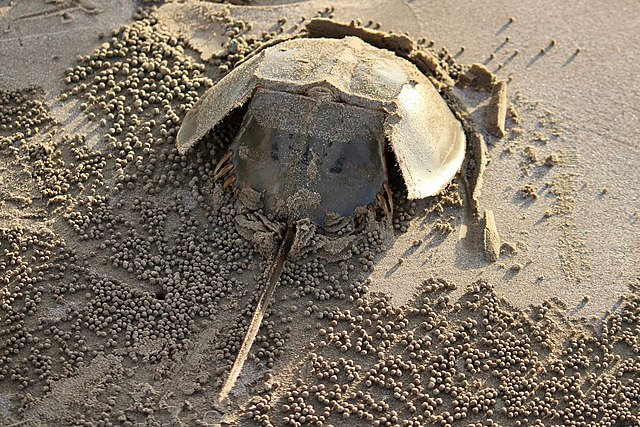
Horseshoe crabs are being ‘killed in vast numbers’ according to ecologists, endangering the species and causing damaging knock on effects on the food chain.
Horseshoe crabs trace their lineage back hundreds of millions of years, standing as enduring relics of a bygone era. Inhabitants of the ocean floor, these enigmatic creatures sustain themselves by foraging on worms, algae, and clams, using their sturdy legs to crush their prey before consumption.
Despite their evolutionary distance from Homo sapiens, horseshoe crabs have assumed a pivotal role in contemporary human existence. Their cobalt-blue blood, a remarkable biological feature, serves as a crucial element in evaluating the safety of various medical interventions, including vaccines and insulin injections.
“Harvesting horseshoe crabs for their blood has saved millions of lives,” said Rich Gorman of Sussex University, author of a recent study of the horseshoe crab. “If you’ve ever been given a vaccine, you can thank the horseshoe crab for ensuring that your jab was safe.”
However, this symbiotic relationship has exacted a toll. Biologists lament the alarming declines in horseshoe crab populations, particularly along the eastern seaboard of the United States, where the relentless extraction of their blood has led to significant mortality rates. Delaware Bay in New Jersey, once a thriving breeding ground, now witnesses a stark reduction in numbers, exacerbating the species’ precarious state.
“The fisheries – such as eel fishing – that used horseshoe crabs as bait are dwindling, and there are alternatives to using their blood for medical products,” said Larry Niles, a wildlife biologist in New Jersey. “So there’s no reason to be killing these animals at all.”
The repercussions extend beyond the horseshoe crab population, cascading into broader ecological ramifications. Reports of dwindling populations of avian species, such as the rufa red knot, underscore the interconnectedness of ecosystems. These migratory birds, reliant on the bountiful supply of horseshoe crab eggs during their stopover in Delaware Bay, now face a dwindling food source, imperilling their arduous journeys to the Arctic.
Moreover, the commercial exploitation of horseshoe crabs for bait further compounds their plight, prompting regulatory measures like the ban on harvesting female horseshoe crabs in Delaware Bay. Yet, many conservationists argue that such interventions are insufficient, advocating for a paradigm shift away from reliance on horseshoe crabs altogether.
Scientific advancements offer promising alternatives to the traditional reliance on horseshoe crab blood for medical testing. Synthetic substitutes, devoid of the ecological toll associated with horseshoe bleeding, have been available for over a decade. However, the widespread adoption of these alternatives has been hindered by regulatory inertia and industry reluctance. Encouragingly, recent regulatory shifts in Europe, Japan, and China, with the United States poised to follow suit, signal a potential shift towards embracing synthetic testing methods, thereby alleviating pressure on horseshoe crab populations.
“Changing the rules will certainly help but we will still have to persuade companies that they need to change their practices and save the horseshoe crab,” said Niles. “They won’t do that overnight.”
The unique properties of horseshoe crab blood, notably its sensitivity to bacterial contamination, have been harnessed for medical diagnostics through the Limulus Amebocyte Lysate (LAL) test. Yet, the procurement process exacts a significant toll on horseshoe crab populations, with mortality rates estimated to range from 15% to upwards of 30%.
As conservation groups highlight the urgent need for action, the imperative to transition towards sustainable and ethical alternatives grows ever more pressing.
“About half of a crab’s blood is taken from each animal and that is simply too much,” said Larry Niles, a wildlife biologist in New Jersey. “They are being killed in vast numbers, and that is having severe ecological consequences not just for the crabs but for other creatures that eat the eggs that the horseshoe crab lays.”
——————————————————————————
At Natural World Fund, we are passionate about stopping the decline in our wildlife.
The decline in our wildlife is shocking and frightening. Without much more support, many of the animals we know and love will continue in their decline towards extinction.
When you help to restore a patch of degraded land through rewilding to forests, meadows, or wetlands, you have a massive impact on the biodiversity at a local level. You give animals a home and food that they otherwise would not have had, and it has a positive snowball effect on the food chain.
We are convinced that this is much better for the UK than growing lots of fast-growing coniferous trees, solely to remove carbon, that don’t actually help our animals to thrive.
This is why we stand for restoring nature in the UK through responsible rewilding. For us, it is the right thing to do. Let’s do what’s right for nature!
Donate today at https://naturalworldfund.com/ and join in the solution!

